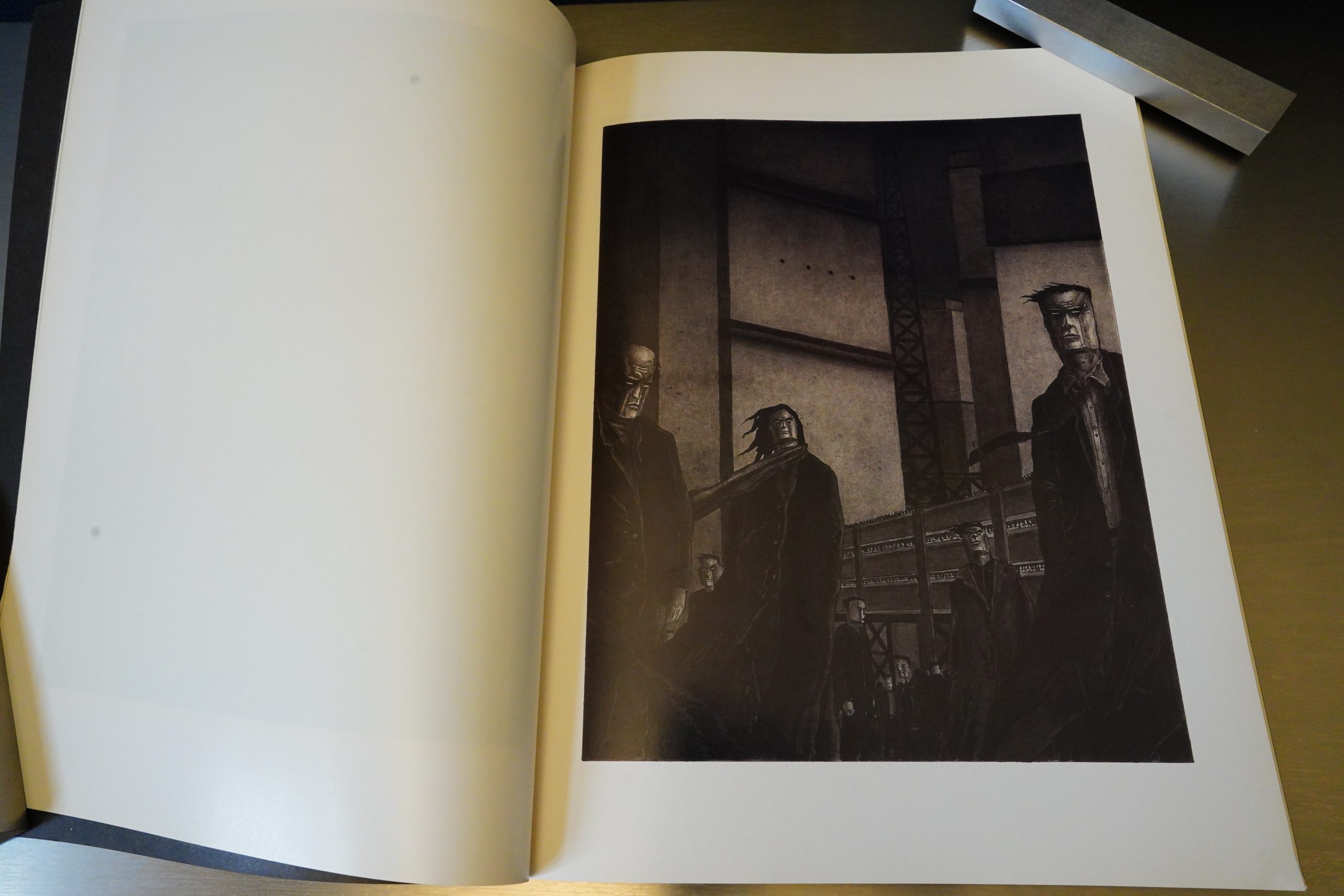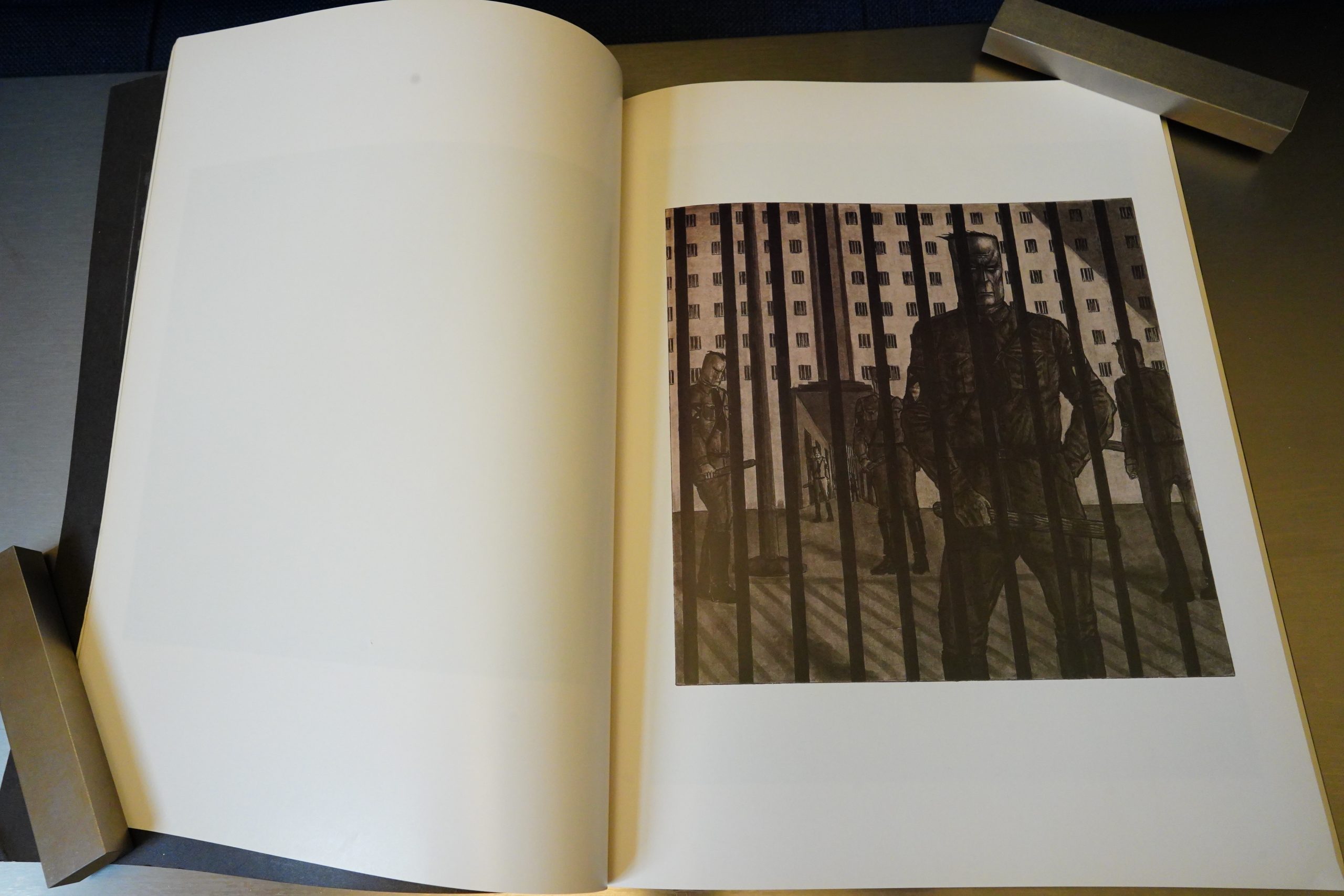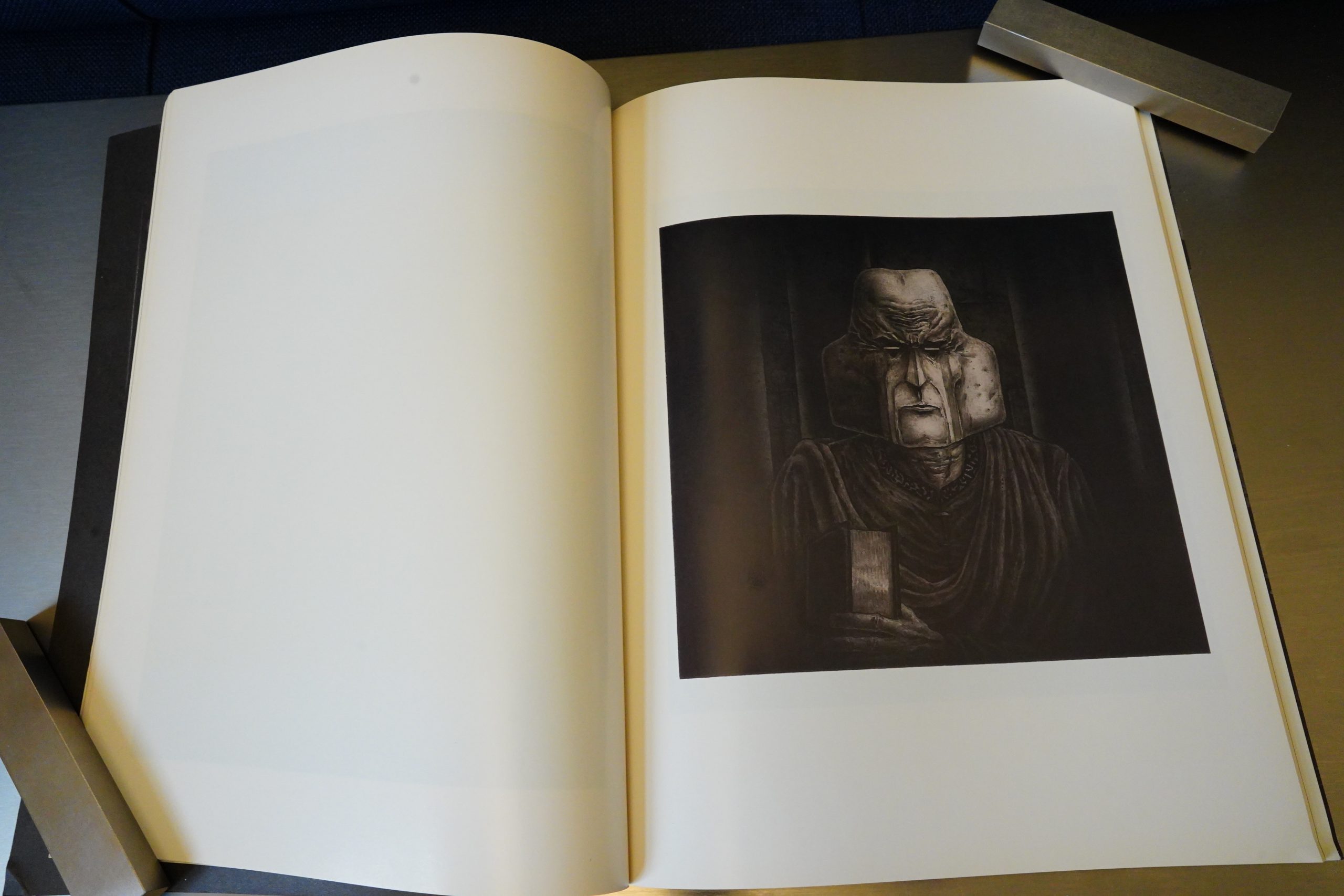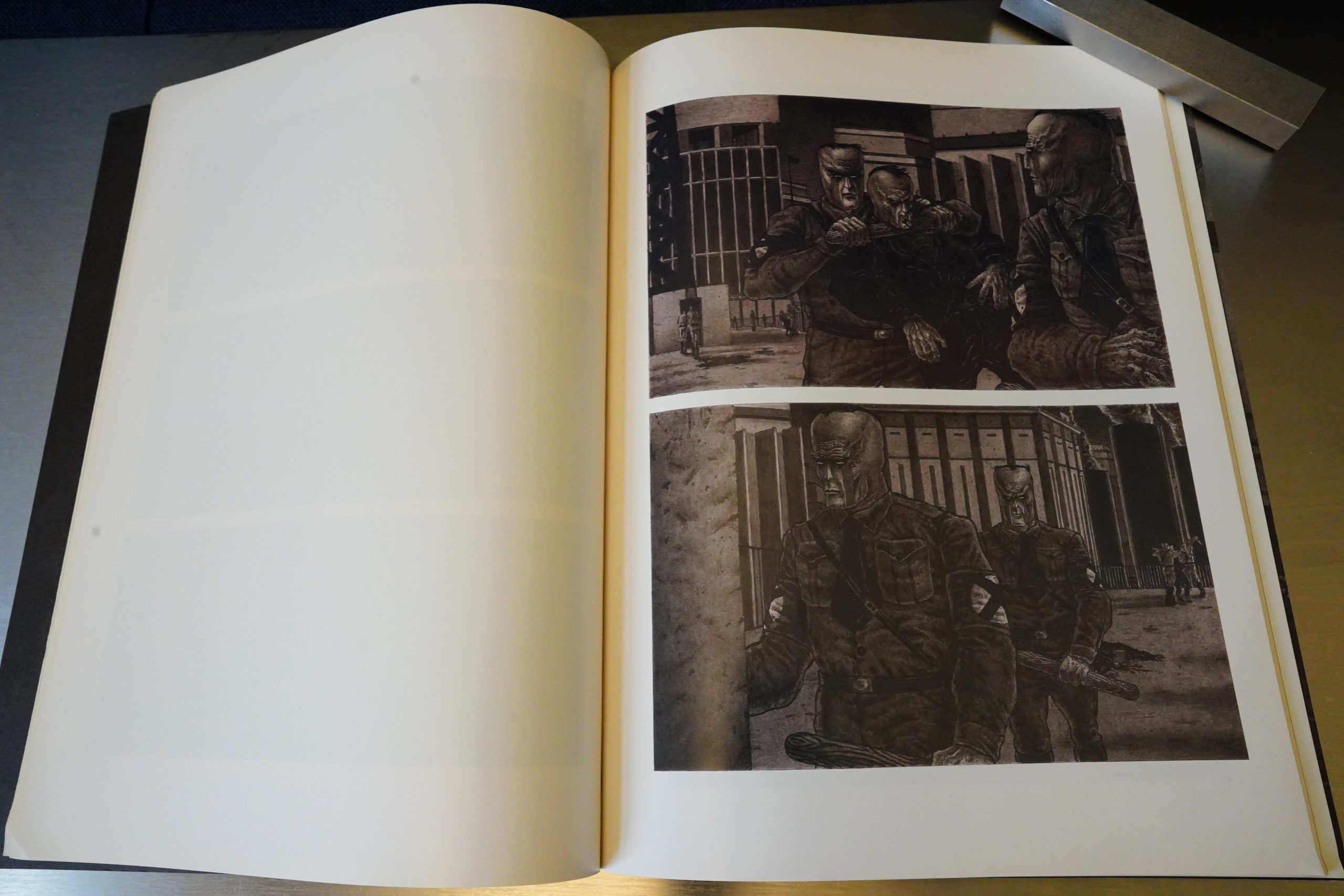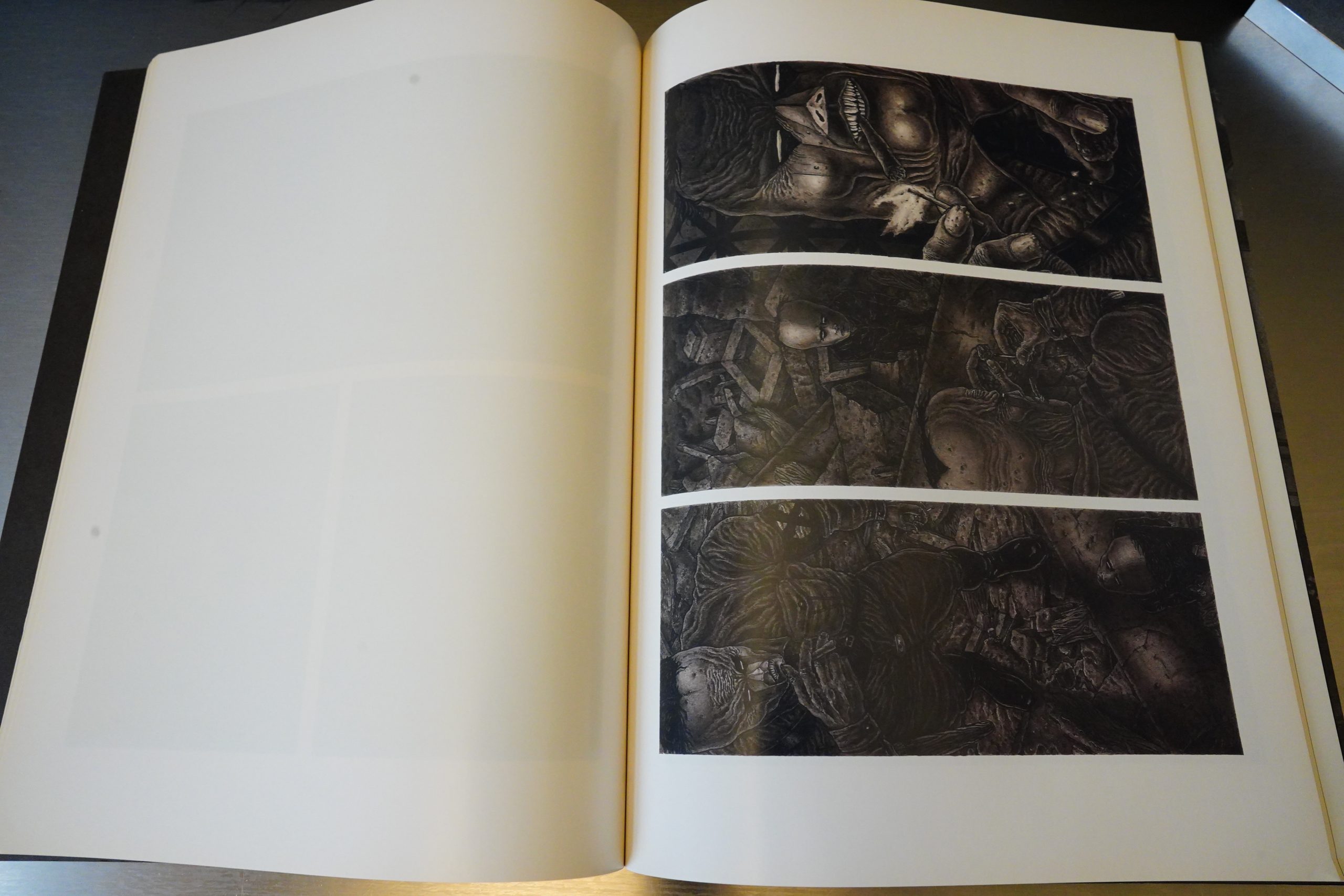The Silent City (1995) by Erez Yakin
“A new breed of visual novel.” Perhaps he hasn’t heard of comics before or something. I mean, it’s possible.
Anyway, this was done in 1988, when the author was 18 years old, allegedly.
I’m saying “allegedly” because it sounds so unlikely, but I guess they wouldn’t lie about something like that. The artwork is pretty accomplished.
And very strange.
It’s a narrative of sorts — I think we follow at least two storylines, but as you can see, there’s not a lot of room to develop much of anything. It’s good a pretty good and moody mood going on, even if I’m not sure what this is all about, except, you know, concentration camps and stuff.
And random pages are drawn sideways.
So… that’s a weird book for Kitchen Sink to be publishing — it’s more of a Tundra kind of thing, I’d have thought. It’s very large (not quite Raw size), and it sold for $25 a pop, which you’d think would be offputting for comics cheapskates, but perhaps Kitchen Sink managed to get the book out to other people? Because if I’m reading the indicia right, what I have here is the second printing.
Ray Mescallado writes in The Comics Journal #181, page 48:
HAVING A STRONG interest in the
way images and text interact in comics, I’m
ambivalent about wordless comics. Too often,
it seems to be an exercise in illustration,
not a serious examination of how we perceive
reality. As a juxtaposed pantomime, the
unchallenging silent comic really isn’t very
different from comics with text — its main
gimmick isn’t the wordlessness, but false
pretension.
This graphic album is slow, resistant to a
speedy flipping-through: Yakin takes
archetypally familiar images and turns them
insistently strange, making the reader pause on
each page. The immediatecomprehension of an
image isn’t enough; one must also search for
further meaning and direction in the details of
each silent tableau.
As a result, The Silent City is also a hell of
a political statement. Doubters can read the
introduction by Russian poet Yevgeny
Yevtushenko: comparing the present work to
Dostoyevsky’s The Possessed, Yevtushenko
writes at length about our modern political
dilemmas and tells us “Yakin has the nostrils of
youth that detect the smell of danger. For this
reason he screams with the silence of his draw-
ings.” Indeed, one can read the graphic album
and find an impassioned Cry On every page.
I didn’t know that Yevtushenko was a fan of
comics, and reading the introduction, I guess
maybe he isn’t. Of The Silent City, he also says
“It is not comics, but tragics. Possibly it is the
beginning of a new genre: the visual novel.”
The ‘tragics” line seems vaguely familiar (prob-
ably from some mainstream assessment of
Maus), and just shows how the medium can be
vastly underrated because ofa seemingly frivo-
lous name. And as Scott McCloud pointed out,
the visual novel — extended, multi-layered
narratives relying on juxtaposed graphic im-
ages — goes back at least to the early part ofthis
century with Frans Masereel and Max Ernst.
Even in the realm Of what we normally
consider comics, “the visual novel” —or
the graphic novel, or the drawn novel, or
the graphic album — has many fine
examples that prove the medium’s
burgeoning maturity.
From Yevtushenko’s obvious
ignorance of comics, however, I
have to confess to a myopia of
my own. Erez Yakin wasacom-
pletely unfamiliar name to me;
for all I know, he’s made a
name for himself in the fine
arts, and this graphic album
was an early experiment in fine
arts narrative. We are told that
this graphic album was accom-
plished at the age of 17, and
that is extraordinary: the passion of young righ-
teousness is evident, but the sheer stamina and
craft ofthis work speaks beyond Yakin’ s years.
Above all else, the art of The Silent City is
haunting: it reminds me of both Enki Bilal and
Katsuhiro Otomo’s work, with its emphasis on
mood and quietly dramatic mise-en-scene. Like
Bilal, Yakin creates a lived-in world, one drained
of emotion: figures inhabit the decayed land-
scape with an air of tragic capitulation. I can’t
help but see Yakin’s work as also being influ-
enced by classic Soviet propaganda, taking the
dynamic proletariats from those posters and
transforming them into a monolithic defeat of
the spirit. Yakin takes the sturdy blockiness of
those propaganda figures and disfigures them
— the denizens of the State are still physically
dynamic, but their heads are shaped like blocks
of flesh, the shape of prison bars impressed on
their cheeks. The setting is equally bleak, an
urban behemoth that dwarfs its populace and
seems to deny the very notion of a “natural
state”.
Yevtushenko describes this work as a
“gulagocaust” and that’ s certainly an angle that
suggests itself. The story is obscurantist, wildly
allusive, and plays hard at achieving a visceral
profundity. But here, it works — the emotional
urgency allows such loftiness. In varying de-
grees, we’re made privy to the actions of sev-
eral characters: a boy living next to a ruined
wall (and the only one who doesn’t have bars
imprinted On his face), a man who appears to be
a renegade, soldiers ofthe state, a clergyman of
some kind. The characters encounter one an-
other, and leave an impact on each other’ s lives.
The exact nature of that impact is clear for
some, ambiguous to others, but this isn’t one of
those cheats where “ambiguous” means “there
isn’t really a story there.” There’s something
clearly taking place right before us, but we’re
not taken by the hand and led through the
events. The silence forces us to hazard guesses
on its significance, to interact with the images
more intensely — I found it impossible to pin
down all the nuances, or even to confirm many
of my suspicions of what’s going on.
Unfortunately, at $24.95 for a 96-page
graphic album, the price tag for The Silent City
is steep to the point of prohibitive for many
readers. Brand me a philistine, but it’d take a
great deal to make me divert my monthly
comix budget towards such an expensive
project. Ifit was half that price, I’d have
no problem recommending this
book wholeheartedly; as it
stands, I’d say at least
look over it to discover
how much it speaks to
you. There’s a better-
than-average chance
you’ll find it worth
purchasing, worth liv-
ing with it on a day-
to-day basis to read
over, ponder, and dis-
cover •
I think the reviewer here leans pretty heavily at the introduction here for his interpretation of the work, which is disappointing.
Uhm:
This book is a perfect reflection of what is left when you exterminate the spiritual element of a society. This is what results when you forcibly amputate the “Holy” from Holy Russia. This is what is left- ashes, and stone, and zombies. It is a place of the living dead. Even the sadism of the police seems to lack any real animating passion. It is just a job, and if they are not brutalizing and humiliating someone (anyone really) then they aren’t doing their job. Nothing personal.
Yeah, it’s better if sadists put some passion into their sadism…
I’m a BIG fan of the publisher but Kitchen Sink really pooped the mattress presenting this. There are nothing but blank pages on the left side the whole way through and you have to turn the whole book when it switches from vertical to horizontal.
The story isn’t nearly up to snuff with the other wordless artists but I gave slack because he was eighteen years old when he completed it.
The art compositions are very repetitive- I felt like I was seeing the same thing constantly.
Well, that’s a more reasonable review:
Mr. Yakin finds it difficult to keep his theme of totalitarian oppression from being a shrill echo of George Orwell’s “Nineteen Eighty-four,” replete with the common visual clichs of fascist brutality. Nevertheless, “The Silent City” is remarkable for its horrific portrayals of unbridled, demonic power, as well as for the difficult, oppressive darkness of its pictures, which makes them at times barely reproducible. “The Silent City” may not have pushed the limits of the wordless novel beyond what was accomplished in the 1930’s, but it proves that Erez Yakin is a virtuoso image maker, a gifted artist at the beginning of what might well be a brilliant career.
And since the New York Times reviewed it, I guess that has to mean that Kitchen Sink were successful in getting it out to a non-comics audience.
I’m unable to find much on Google about Erez Yakin, but he apparently did another book at Vertigo?
This is the one hundred and eighty-ninth post in the Entire Kitchen Sink blog series.



